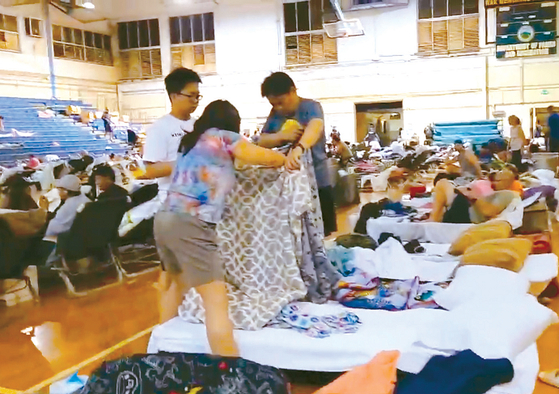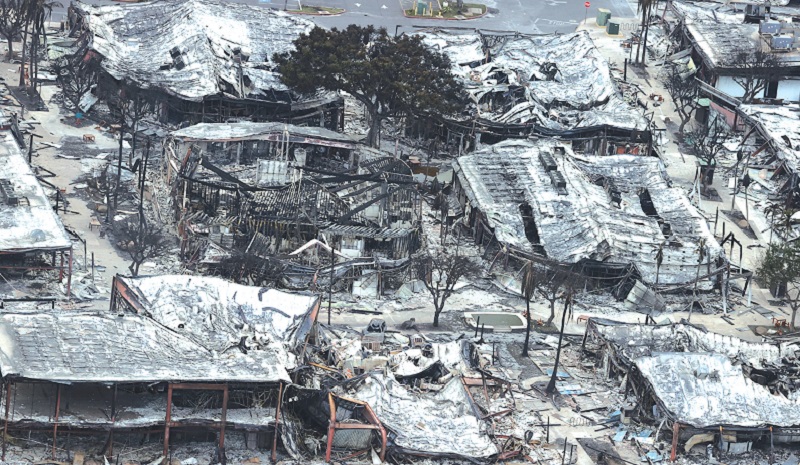
“It was like something from a disaster movie,” recalled Ahn Byung-yoon, a tourist from South Korea, as he described the harrowing experience of evacuating during the wildfires that swept through the island of Maui. In a trembling voice, Ahn recounted the intensity of the situation he faced.
“I could see the smoke gradually engulfing Lahaina. The smell of smoke was intoxicating. I could see flames on the mountainside, and I realized I could die at any moment. I had no passport, no luggage, and was wearing flip-flops. I obtained an emergency passport at the consulate because I had no ID. Now I’m on my way to Honolulu,” Ahn recounted.
Reports of the catastrophic events, including Ahn Byung-yoon’s account, continue to pour in from the affected regions. According to the Hawaii State Emergency Management Agency (HEM), as of 5 p.m. on August 10, the death toll from the wildfires has climbed to 53, with 1,700 homes and other structures obliterated, and over 2,000 acres consumed by flames.
“Firefighters are tirelessly battling flare-ups and struggling to contain the fires in Lahaina, Pulehu/Kihei, and Upcountry Maui,” stated Maui County officials, acknowledging the challenge posed by the fierce winds stemming from the impact of Hurricane Dora.
The casualty count and acreage devoured by the fires are expected to rise further as the firefighting efforts persist.
“At this time, we can’t ascertain the full extent of the damage. Our primary focus is on extinguishing the fires and carrying out rescue operations,” a fire official conveyed to the media. The areas hit hardest in Lahaina are believed to have suffered substantial destruction.

On a brighter note, the infernos are gradually being brought under control. “Lahaina has achieved an 80 percent containment rate, and the Pulehu fire, situated in a region mauka of Kīhei, has reached a 70 percent containment level,” fire officials confirmed during a briefing at 3 p.m. on August 10. As of now, six fires are raging concurrently in the area, a complex challenge to manage, especially considering the fires’ expansion from remote canyons in the kula.
Presently, around 11,000 households are without electricity, and helicopters are being deployed to continue the search for individuals who have yet to vacate the affected zones, reported the Hawaii Emergency Management Agency (HEM) in a live situation report.
Shelters remain open around the clock. The Maui County government has organized a fleet of five buses to facilitate the transportation of residents from wildfire-impacted areas to evacuation centers, and tourists to the airport.
The four shelters on the island currently provide refuge for over 2,000 residents and tourists. The Hawai‘i State Department of Health (DOH) Maui Community Mental Health Center (CMHC) is extending its hours and offering crisis mental health services to those grappling with emotional or psychological distress in the wake of the Maui wildfires.
As the death toll continues to climb, Hawaii Governor Josh Green conveyed his condolences and directed the state legislature to lower the national flag to half-mast.
President Joe Biden officially declared the Hawaiian Islands a major disaster on August 10.
“The President’s declaration enables Federal assistance for affected individuals in Maui County. This aid encompasses grants for temporary housing and home repairs, low-cost loans to cover uninsured property losses, and other programs designed to help individuals and business owners rebound from the aftermath of the disaster,” announced the White House.
Meanwhile, the Maui wildfires are poised to be remembered as the most severe natural disaster in Hawaii’s history. The last instance of such widespread devastation was in 1961 when a tsunami claimed the lives of 61 individuals on the Big Island of the Hawaiian Islands.
BY YEOL JANG [jang.yeol@koreadaily.com]
Instagram에서 이 게시물 보기



![Green card interviews used as decoy for ICE arrests U.S. Immigration and Customs Enforcement (ICE) agents arrest a man after a hearing at an immigration court in Manhattan, New York, on Oct. 27. [REUTERS]](https://www.koreadailyus.com/wp-content/uploads/2025/12/1226-ICE-100x70.jpg)
